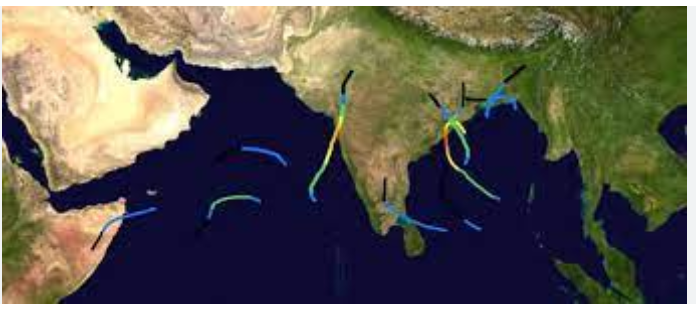North Indian Ocean Cyclone Season
The North Indian Ocean cyclone season is an annual event that occurs from April to December, with peak activity between May and November. This region, which includes the Bay of Bengal and the Arabian Sea, is prone to the formation of tropical cyclones that can cause significant damage to coastal areas and result in loss of life and property.
Overview
The North Indian Ocean is one of the most active basins for tropical cyclones in the world. On average, the region experiences four to six cyclones per year, with one to two of them being severe cyclonic storms. These cyclones are formed when the warm waters of the Indian Ocean evaporate and create a low-pressure area, which then rotates and intensifies due to the Coriolis force.
Factors Influencing Cyclone Formation
Several factors influence the formation of cyclones in the North Indian Ocean:
- Sea surface temperature: Cyclones require warm sea surface temperatures of at least 26.5°C to form and intensify.
- Vertical wind shear: Low vertical wind shear allows the cyclone to maintain its structure and intensity.
- Monsoon trough: The monsoon trough, a low-pressure area that extends from the Bay of Bengal to the Arabian Sea, provides favorable conditions for cyclone formation.
- Madden-Julian Oscillation (MJO): The MJO, an eastward-moving disturbance of clouds, rainfall, winds, and pressure, can enhance cyclone activity when it is in a favorable phase.
Classification of Cyclones
The India Meteorological Department (IMD) classifies tropical cyclones in the North Indian Ocean based on their maximum sustained surface wind speed:
- Low-pressure Area: Wind speed less than 31 km/h
- Depression: Wind speed between 31 and 49 km/h
- Deep Depression: Wind speed between 50 and 61 km/h
- Cyclonic Storm: Wind speed between 62 and 88 km/h
- Severe Cyclonic Storm: Wind speed between 89 and 117 km/h
- Very Severe Cyclonic Storm: Wind speed between 118 and 166 km/h
- Extremely Severe Cyclonic Storm: Wind speed between 167 and 221 km/h
- Super Cyclonic Storm: Wind speed above 222 km/h
Impact on Indian Subcontinent
Cyclones in the North Indian Ocean can have a devastating impact on the Indian subcontinent, particularly on the eastern and western coastal regions. Some of the most severe cyclones in recent history include:
- Cyclone Amphan (2020): Caused widespread damage in West Bengal and Bangladesh, resulting in over 100 deaths and economic losses of over $13 billion.
- Cyclone Fani (2019): Made landfall in Odisha, causing extensive damage and displacing millions of people.
- Cyclone Ockhi (2017): Affected the southern states of Kerala and Tamil Nadu, causing significant damage to infrastructure and claiming over 200 lives.
Cyclones can lead to storm surges, heavy rainfall, and strong winds, which can cause flooding, landslides, and damage to buildings and infrastructure. They also pose a significant threat to the lives and livelihoods of people living in coastal areas, particularly those from vulnerable communities.
Disaster Management
To mitigate the impact of cyclones, the Indian government has implemented various disaster management measures:
- Early warning systems: The IMD uses satellite imagery, radar, and weather models to track and predict the path of cyclones, issuing timely warnings to the public and authorities.
- Evacuation plans: State and local authorities have developed evacuation plans to move people from vulnerable areas to cyclone shelters and safer locations.
- Disaster response teams: The National Disaster Response Force (NDRF) and State Disaster Response Forces (SDRFs) are deployed to conduct search and rescue operations and provide relief to affected areas.
- Infrastructure development: The government has invested in the construction of cyclone shelters, embankments, and early warning systems to reduce the impact of cyclones on coastal communities.
Climate Change and Future Outlook
Climate change is expected to have a significant impact on the frequency and intensity of cyclones in the North Indian Ocean. Rising sea surface temperatures and changing weather patterns could lead to more severe and frequent cyclones in the coming years.
To address this challenge, India has taken several steps to enhance its cyclone preparedness and resilience:
- National Cyclone Risk Mitigation Project (NCRMP): This World Bank-funded project aims to improve the country’s capacity to respond to and recover from cyclones, through the construction of cyclone shelters, early warning systems, and capacity building of local communities.
- Climate change adaptation: India has developed a National Action Plan on Climate Change (NAPCC) which includes measures to build resilience against extreme weather events like cyclones.
- International cooperation: India is a member of the World Meteorological Organization (WMO) and participates in regional and global initiatives to improve cyclone forecasting and disaster management.


